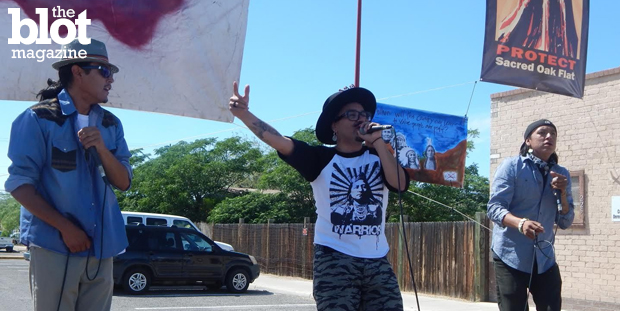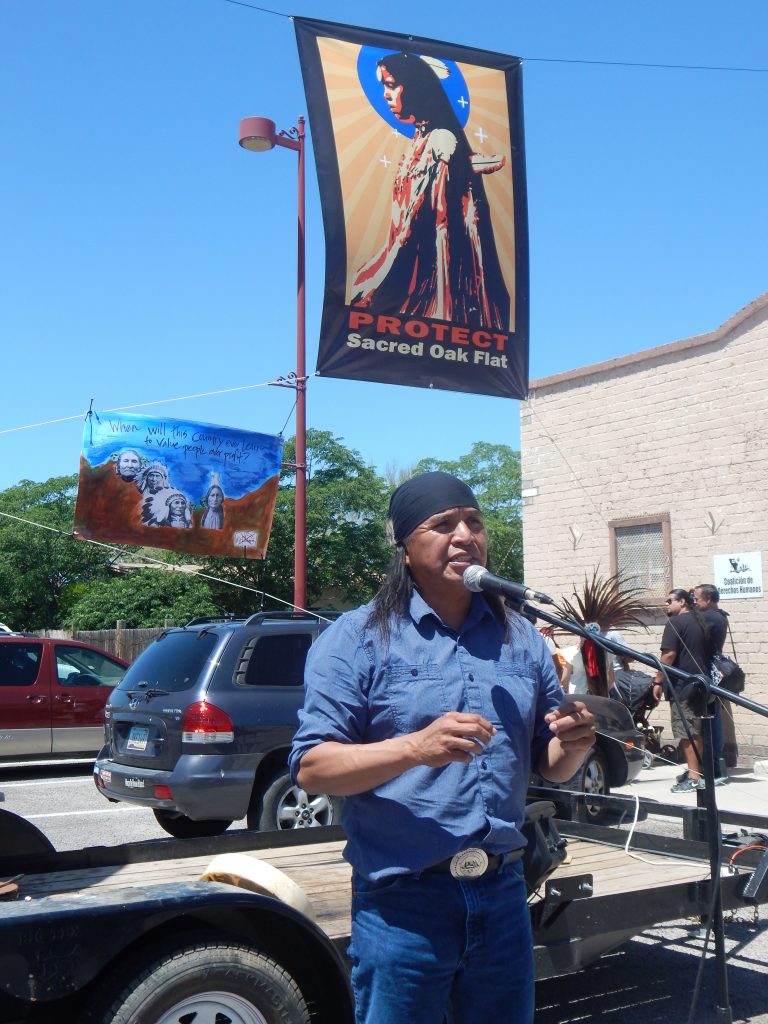Members of Arizona’s San Carlos Apache Tribe are not giving in to a giant conglomerate that wants to take its ancestral land so it can be mined. This past weekend, the tribe held the Save Oak Flat Street Fair in Tucson, Ariz. — named for its ancestral and sacred land — to bring more attention to the project it believes will forever contaminate and harm the pristine and hallowed environment of the Tonto National Forest, about 90 miles northeast of Phoenix.
“It was [Sen. John] McCain’s home turf there,” Tribal Elder Sandra Rambler said in a phone interview with TheBlot Magazine. “He was really blasted. It’s bringing more awareness. We’re not going away.”
The campaign is called “Apache Stronghold” and provided information in pamphlets, posters, newsletters and other formats to residents. Members of San Carlos Apache and other tribes from Arizona and other states joined in the street fair event.
Comparing the project to a scorpion that won’t die, Rambler bared her emotions over what she believes is an injustice to her people, saying that she wishes mining interests with help from the federal government would just “leave us alone, go pick on someone else.”
In February, tribal members traveled more than 40 miles in a spiritual walk and protest against their land being taken and continue to explore all possible ways to oppose the joint venture between the Australian-English multinational mining, metals and petroleum companies. Rambler said the tribe continues to lobby lawmakers and is considering going to the United Nations to state its case against the project that is a partnership between Rio Tinto and BHP Billiton, though a subsidiary of the former — Resolution Copper — will do the work digging up a copper deposit there.
Aside from its likely devastating environmental impact, how the project got approved stinks. It was slipped into the 2015 National Defense Authorization Act (NDAA) at the eleventh hour. The land swap was negotiated in closed talks between the House and Senate Armed Services Committees and only became public when the entire 2015 NDAA was approved by Congress.
“Resolution Copper has failed to offer any substantive plans to protect groundwater and surface water,” tribal member Alex Ritchie wrote in an e-mail to TheBlot.
Contamination of already-limited drinking water and a gaping pit in the forest are not the only fears San Carlos Apache members have. The project was pushed through with promises of jobs for local people and a boost to the economy, but as jobs go, this is an empty promise.
Incredibly, both Sens. John McCain and Jeff Flake supported the Southeast Arizona Land Exchange and Conservation Act. McCain, who serves on the Senate Armed Services and Indian Affairs Committees, was largely responsible for the act being added to the larger bill. He and Flake then touted the measure as an economic benefit that will add more than 3,500 jobs to the area. But reaching that figure could take years and with concurrent increasing machine automation and advancing technology, the supposed number of 3,700 jobs is about as easy to catch and hold as a shooting star.
Through his research, Ritchie found that only 4 percent of wages from the value of minerals get to residents. It is also highly dubious that mining actually increases employment. From 1974-1997, copper production in Arizona rose by 73 percent, but jobs were cut 56 percent due to automation and technological advances that made many obsolete. “Automation severely reduces the number of employees for drilling, blasting, train and truck driving,” Ritchie said.
Read more: Stepping on Sacred Ground: Defense Bill Includes Native American Land Grab
In a state covered by deserts, to give away vital land to a project that will consume up to 20,000 acres of water each year seems like not just a bad idea but incredibly reckless. That is roughly equivalent to the amount of water used each year by a city of 180,000 people, according to research conducted by the tribe.
And even worse, the Resolution Copper will not say how existing water in the region will remain protected. The project will also affect Phoenix and its surrounding metropolitan region of more than four million people. The mine will be located at the headwaters of the cities’ water supply. “The proposed mine will deplete the aquifers that support the flows to Queen Creek,” Ritchie said. “The subsidence of land caused by the mine could impact the recharge of the groundwater aquifers, and toxins pumped into the ground can contaminate the water throughout the region.”
Rambler said the street fair and fundraising event was held not only to bring further outside attention to the cause but also to get young people in the area involved. “It was a really good feeling getting the youth involved,” she said. “When the youth come in, they make it really lively.”
Other efforts undertaken to fight the reprehensible land grab included the February spirit walk and holy ground ceremony where tribal members journeyed on a two-day march from their administration headquarters to the city of Globe, Ariz., ending at Oak Flat Campground. Afterward, some stayed holding prayer ceremonies and have occupied the site since.
“They are up there getting it ready and praying … singing, getting drums ready and drumming, praying and gathering. It’s all intertwined with Mother Earth,” Rambler shared.
Though Rambler and others are doing everything they can, the possibility that her tribe’s ancestral land will be scarred forever scares her. She even had a nightmare about the coming mine as she audibly got upset while recounting the devastation it will bring to the area during our phone call. “It was real traumatic for me,” she explained.
Maybe the only good thing to come of the project is opposition. It is tying many in the tribe together around a common cause. And smart thing the bill’s writers or whoever named it threw “conservation” in the title, otherwise the act could have gone by the acronym SALE, which would hardly belie what it truly is.
The supposed land exchange would have the federal government release 2,400 acres in the Tonto National Forest to the subsidiary Resolution Copper in exchange for other parcels. The Apache reservation borders forestland that has been used by tribes in the area for centuries.
To Rambler, defending the ancestral and sacred land is no choice. It is a matter deeply embedded in the fiber of the tribe.
“This is our religion,” she said. “Our Apache way of life, this is what has been engrained in our minds since birth. ”
Noah Zuss is a reporter for TheBlot Magazine.









2 Comments
Leave a Reply